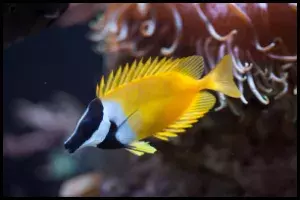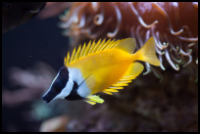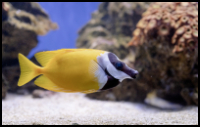





Quick Care Details (Table)
| Livestock Characteristics | Value |
|---|---|
| Care Level | Easy |
| Temperament | Peaceful |
| Diet | Herbivore |
| Maximum Size | 9 Inches |
| Minimum Tank Size | 125 Gallons |
| Plant Safe | Yes |
| Temperature Range | 72-78°F |
| PH Range | 8.1-8.4 pH |
| Alkalinity Range | 8-12 dKH |
| salinity | 1.022-1.025 |
Species Specific Categories
Helpful Video
Care Details
Aquascape:
- Use live rock formations and coral structures to create hiding spots and open areas.
- Mimic natural reef environments with caves, overhangs, and crevices.
Substrate:
- Choose fine sand as a substrate to replicate their natural foraging behavior.
- Avoid coarse substrates to prevent injury while sifting through the substrate.
- These fish will pick at the substrate and swallow it if it has algae growing on it.
Disease Prevention:
- Quarantine new Foxface before introducing them to the main tank.
- Maintain excellent water quality and hygiene to minimize stress and disease risks.
Filtration:
- Employ a quality protein skimmer and efficient biological filtration.
- Regular water changes help eliminate waste buildup and maintain stable conditions.
Lighting:
- Provide suitable reef lighting with the right spectrum and intensity.
- Ensure lighting promotes healthy coral growth and enhances their vibrant colors.
Water Flow:
- Simulate natural water movement with powerheads or wavemakers.
- Moderate water flow is ideal; avoid strong currents that might stress them.
Hardiness:
- Foxface are generally hardy and adaptable to varying conditions.
- Maintain stable water parameters to prevent stress-related health issues.
Acclimation:
- Gradually acclimate new Foxface over several hours using the drip method.
- Ensure consistent temperature and salinity during the acclimation process.
Special Requirements:
- Different Foxface species may have unique care needs based on coloration, size, or diet.
- Research the specific Foxface species you have to provide the appropriate care.
Temperament and Behavior
Behavior and Social Interaction:
- Foxface are generally peaceful and solitary, often seen alone or in small groups.
- They may establish territories and prefer a calm environment.
- These fish exhibit a curious and cautious demeanor, exploring their surroundings.
Aggression:
- While usually peaceful, Foxface can display aggression towards their own species or similar-looking fish.
- Aggressive behavior might involve chasing, territorial disputes, or fin nipping.
Breeding:
- Breeding Foxface in captivity is challenging and uncommon.
- In the wild, the Foxface will release eggs and sperm into the water column, where fertilization occurs.
- Successful breeding requires specific conditions and care, often beyond the scope of home aquariums.
Compatibility:
- Compatible tank mates include other peaceful fish that won't outcompete or harass them.
- Avoid housing them with aggressive or territorial species, which could lead to conflicts.
Activity Level:
- Foxface are moderately active swimmers.
- They explore their environment and may occasionally perch on rocks or corals.
Clean up Crew:
- Foxface isn't typically going to eat leftover foods.
- They primarily graze on algae and plant material, rather than actively scavenging detritus.
Schooling or Shoaling Behavior:
- While Foxface might be seen in small groups in the wild, they don't exhibit tight schooling or shoaling behavior.
- They're more likely to establish territories or swim individually.
Coral Reef Compatability
- These fish will generally not attack coral and are normally reef safe.
- They on rare occasions might attack a soft coral like a zoa assuming it is algae or maybe trying to get algae near it.
- They will not attack invertebrates like shrimp, snails, or crustaceans.
Diet and Nutrition
Dry Foods:
- Provide high-quality, plant-based pellets or flakes.
- Look for foods with algae, spirulina, and other plant ingredients.
- Pellets can sink slowly, allowing these rabbitfish to graze.
Frozen Foods:
- Offer frozen options like mysis shrimp, brine shrimp, and spirulina-enriched mixes.
- Thaw and rinse frozen foods before feeding to remove excess salt and nutrients.
Live Foods:
- The Foxface fish generally do not rely on live foods.
- If desired, you can occasionally offer live or freshly hatched brine shrimp.
Vegetables:
- Foxface fish are herbivores that enjoy vegetable matter.
- Offer blanched and chopped vegetables like spinach, lettuce, and seaweed sheets.
Algae:
- Foxface fish actively graze on algae in the wild.
- Include live rocks with algae growth in the tank to encourage natural foraging behaviors.
Feeding Schedule:
- Feed these rabbitfish small amounts 2-3 times a day.
- Avoid overfeeding to prevent waste buildup and maintain water quality.
Supplemental Foods:
- Supplement the diet with high-quality aquarium-safe supplements.
- Vitamin-enriched foods can provide essential nutrients.
Tank Parameters
Tank Size:
- A tank size of at least 125 gallons is recommended for the Foxface.
- A larger tank allows for better swimming space and reduced territorial conflicts.
Tank Length and Measurements:
- An ideal tank length for the Foxface would be around 6 feet.
- This provides ample horizontal swimming space and accommodates their moderate size.
Species Maximum Size:
- Depending on the species, Foxface can grow to be around 6 to 10 inches in length.
- Consider the growth potential when planning tank size and compatibility.
Water Temperature:
- Maintain a water temperature between 74 to 80°F.
- Keep the temperature stable to prevent stress and health issues.
pH (Acidity/Alkalinity):
- Maintain a pH level between 8.1 to 8.4.
- Stable pH levels are essential for the well-being of the Foxface.
Nitrate (NO3) Levels:
- Keep nitrate levels as low as possible, ideally below 30 ppm.
- Regular water changes and proper filtration help control nitrate levels.
Salinity:
- Maintain a salinity level of 1.020 to 1.025 specific gravity.
- Stable salinity is crucial for osmoregulation and overall health.
Phosphate (PO4):
- Aim for low phosphate levels, ideally below 0.05 ppm.
- Proper filtration and maintenance help manage phosphate levels.
Alkalinity (dKH):
- Alkalinity levels should be around 8 to 12 dKH.
- Stable alkalinity supports proper pH buffering.
History, Popularity, History and Species Variety Details
The History, Popularity, and Habitat of the Foxface Fish
History:
The Foxface fish, scientifically known as the genus Siganus, belongs to the family Siganidae. These striking marine species have a rich history intertwined with the exploration of coral reefs and tropical marine ecosystems. They have been a subject of interest to both scientists and marine enthusiasts due to their intriguing behaviors and captivating appearances.
Popularity:
Foxface rabbitfish have gained popularity among aquarium hobbyists for their vibrant colors, unique patterns, and their role as herbivores that help control algae in reef tanks. Their distinctive rabbit-like snouts and cautious yet curious nature have made them a sought-after addition to both beginner and experienced aquariums. Their presence adds not only visual appeal but also contributes to the ecological balance of marine systems.
Habitat:
In their natural habitat, Foxface inhabit coral reefs and rocky areas in the Indo-Pacific region, including the Red Sea, the Indian Ocean, and the western and central Pacific Ocean. They are commonly found in shallow lagoons, coastal reefs, and slopes with plenty of crevices, overhangs, and coral formations. These features provide them with hiding spots and shelter while allowing them to browse on algae and plant matter.
Foxface are adapted to the vibrant and complex ecosystems of coral reefs, often forming small groups or solitary individuals. Their striking coloration serves both as camouflage among coral structures and as a warning to potential predators, as some species possess venomous spines on their dorsal and anal fins.
Their habitat's crystal-clear waters, abundant marine life, and intricate coral formations have made Foxface rabbitfish an iconic representation of the dazzling underwater world that has captivated marine enthusiasts and researchers alike. Due to their intriguing behaviors and stunning appearances, they are often featured in documentaries and literature highlighting the wonders of marine ecosystems.
In the aquarium trade, their popularity stems from their ability to adapt to captive conditions and their compatibility with reef tanks. However, responsible sourcing and proper care are crucial to ensure the well-being of these remarkable marine inhabitants.
Other Types of Foxface Fish
Magnificent Foxface (Siganus magnificus):
Features vibrant yellow coloration with a striking black eye mask.
Known for its elegance and peaceful demeanor.
One-Spot Foxface (Siganus unimaculatus):
Recognizable by a single black spot on its body, usually near the tail base.
Displays varying shades of yellow or brown.
Bicolor Foxface (Siganus uspi):
Exhibits a distinct color pattern with a white anterior half and yellow or orange posterior half.
Resembles a yin-yang symbol in appearance.
Common Tankmates
Clownfish (Amphiprion spp.): Peaceful and colorful, they make great companions for Foxface in a reef tank.
Royal Gramma (Gramma loreto): Small, vibrant, and peaceful, they add color to the tank without causing issues.
Chromis (Chromis spp.): These schooling fish add movement and color to the tank while coexisting peacefully with Foxface .
Firefish Goby (Nemateleotris spp.): Active and peaceful, they inhabit the upper levels of the tank, complementing Foxface fish's mid-level activity.
Yellow Tang (Zebrasoma flavescens): If the tank is adequately sized, these tangs can coexist with Foxface due to their different swimming levels and behaviors.
Fairy Wrasse (Cirrhilabrus spp.): Peaceful and colorful, they bring vibrant activity to the tank without causing conflicts.
Blennies (Various species): Some blennies are suitable tank mates due to their small size and non-aggressive behavior.
Cardinalfish (Apogonidae spp.): These peaceful fish are relatively small and add diversity to the tank's inhabitants.
Damsels (Chrysiptera spp.): Some damsels are peaceful and can be compatible, but choose carefully to avoid aggressive species.
Anthias (Pseudanthias spp.): Certain anthias species can coexist peacefully with Foxface, adding both color and movement.
The Venomous FoxFace Rabbitfish
Venomous Spines:
The venomous spines of the Foxface rabbitfish are not true "stingers" like those found in some other venomous marine species, such as lionfish or stonefish. Instead, they are sharp, needle-like structures connected to venomous sacs located at the base of the spines. When the Foxface feels threatened, it can erect these spines, making them stand out and potentially causing injury to any creature that attempts to eat or handle it.
Composition of Venom:
The venom contained within the sacs is a mixture of different compounds, including proteins and peptides. These compounds are likely responsible for the painful and sometimes debilitating effects of a sting from the Foxface. The venom can cause intense local pain, swelling, and even systemic symptoms in some cases.
Defense Mechanism:
When a Foxface feels threatened, it can unfurl its venomous spines in an attempt to ward off predators. The spines are sharp and can potentially puncture the skin or mouth of a predator, delivering the venom and causing discomfort or injury. This defense mechanism is particularly effective against smaller predators that may attempt to prey on the Foxface.
Interactions with Humans:
While Foxfaces are not aggressive and generally avoid human interaction, accidents can happen when people are maintaining aquariums that house these fish. Careless handling or accidental contact with the venomous spines can result in painful stings. The symptoms of a Foxface sting can include pain, swelling, redness, and even more severe allergic reactions in some individuals.
Treatment and Precautions:
If stung by a Foxface, it's important to seek medical attention, especially if the symptoms are severe or if an allergic reaction occurs. Immersing the affected area in hot water (as hot as can be tolerated) may help alleviate pain and break down some of the venom's proteins, but professional medical assessment is crucial.
When keeping Foxfaces in aquariums, it's important to exercise caution and wear protective gloves if necessary when performing maintenance tasks that involve handling the fish. Avoiding sudden movements and providing the fish with a calm and stable environment can also help prevent unnecessary stress that might trigger their defense response.
Frequently Asked Questions
Are Foxface fish venomous?
Yes, some species of Foxface fish have venomous spines on their dorsal and anal fins. While not typically aggressive, they can use these spines for defense. Handle them with care.
Can Foxface fish help control algae in my tank?
Yes, Foxface fish are effective algae grazers and can help control algae growth in your aquarium.
Do Foxface fish require a specific diet?
Foxface fish are herbivores and primarily feed on algae and plant matter. A diet of high-quality prepared foods, along with occasional fresh or frozen vegetables, will meet their nutritional needs.
Are Foxface fish reef-safe?
Yes, most Foxface species are considered reef-safe as they usually don't bother corals or other invertebrates. However, be cautious if they start nipping at corals.
Can I keep multiple Foxface fish together?
It's generally recommended to keep only one Foxface fish per tank to avoid territorial disputes and aggression, as they can be aggressive towards their own kind.

